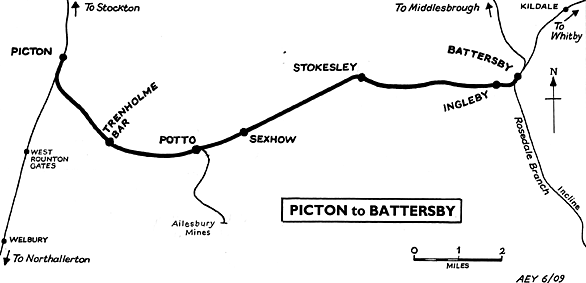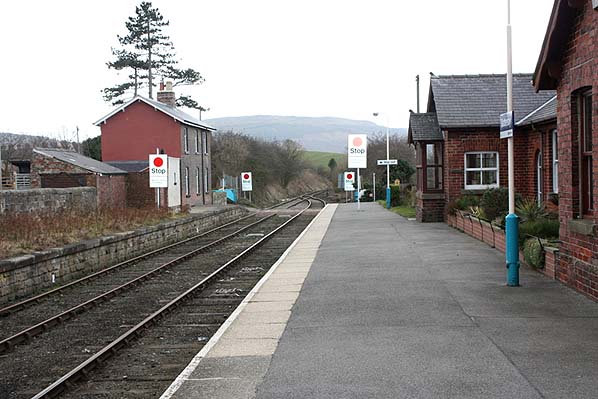
Station Name: BATTERSBY
|
| Date opened: | 6th April 1868 |
| Location: | At the end of an approach road running north from Stone Stoup Hill |
| Company on opening: | North Eastern Railway |
| Date closed to passengers: | Still open |
| Date closed completely: | Still open |
| Company on closing: | Still open |
| Present state: | Only the former northbound platform remains in use, the track has been lifted in the adjacent bay platform. The southbound platform retains its track and could be used for reversing trains, the stationmaster's house still stands at the south end of the platform. The main station building still stands on the northbound platform and a water column has been preserved at the north end of the platform. |
| County: | North Yorkshire |
| OS Grid Ref: | NZ589073 |
| Date of visit: | 12th March 2009 |
|
Notes: Battersby Station opened on 6th April 1868 when the Picton line was extended from Ingleby to Nunthorpe via Ayton (later Great Ayton), it was initially called Ingleby Junction. Early timetables incorrectly show Ingleby itself as the junction, with Ingleby Junction first appearing as a separate station for the line to Ayton in December 1868 although it doesn't appear in Whitby line timetables until June 1874. The station was renamed to Battersby Junction in on 30th 1878 to avoid confusion with Ingleby station. From Battersby Junction and 11 mile mineral railway ran south across the moors to reach iron ore deposits in the Rosedale valley. Although primarily for freight traffic, local residents were allowed to travel on goods trains with 'stations' at Incline Top, Blakey Junction & West Rosedale. All passenger carriage stopped with the closure of the railway on 13th June 1929. Initially Battersby had three platforms two through platforms connected by a central footbridge, along with a shorter bay platform with a run-round loop used by trains to Nunthorpe. Water towers were located at both ends of the station. That at the north end of the station still survives although the signalbox which once stood at the north end of the platform has now been demolished. With the withdrawal of through trains to Picton in 1954 all services have to reverse in the station. Until the rationalisation of the signalling in the late 1980's it was common for two trains to reverse at the same time, in order to pass each other on the single track Esk Valley line. Following the closure of the bay platform trains can still pass each other in the one remaining platform, using the 'first in, last out' principle, as the platform line is signalled to permit two trains to occupy it at once. Today four daily trains run in each direction from Battersby, to Middlesbrough northbound and Whitby eastbound. There is also a Sunday service (five trains each way) in operation from May to September. Although 'Junction' was dropped from the name in 1893 some maps still show the station as Battersby Junction. The Leeds Northern Railway and the West Hartlepool and Harbour Railway jointly promoted the Esk Valley route with the prospect of exploiting traffic in the movement of ironstone from the mines that were developing in the area.
The section between Stokesley and Ingleby was opened on 1st February 1858 and this was further extended to Ingleby Junction (now Battersby) on 6th April 1858, where it joined with the private narrow gauge line from the Ingleby Manor mine, and then continued as far as Kildale. On 31st July 1854 the Leeds Northern Railway became a constituent company of the amalgamation forming the North Eastern Railway. The North Eastern Railway took over full control of the North Yorkshire and Cleveland Railway in 1859. The North Yorkshire and Cleveland Railway had planned a branch from Ingleby Junction to ironstone mines at West Rosedale and had agreed to upgrade the narrow gauge railway as part of the route. The North Eastern Railway took over the project and completed the line for its opening on 27th March 1861. This included a double track rope operated incline 1430 yards long.
The Kildale to Castleton section opened. On 1st April 1861 with Commondale and Castleton stations coming into use. An ironstone mine was opened at Commondale in 1863 and local blast furnaces were planned. However the poor quality of stone made winning it unviable, so the plans were not realised and closure was inevitable. In 1864 a goods only branch was opened from Battersby to join the Middlesbrough and Guisborough line at Nunthorpe Junction. This allowed trains from the Rosedale branch a shorter route to the iron making facilities in Teesside and Co Durham. A further branch was opened to the Rosedale East mines from a moorland junction at Blakey on 18th August 1865 and traffic from the Rosedale mines by 1870 amounted to 1000 – 1500 tons of ironstone each day, which made night working necessary. A spur to allow direct running from the Grosmont direction to Nunthorpe avoiding reversal at Ingleby Junction was approved but never built. The Esk Valley line was completed between Castleton and Grosmont and was brought into use on 2nd October 1865 along with the intermediate stations of Danby, Lealhome, Glaisdale and Egton so joining up with the existing Whitby and Pickering railway and providing a through route between Stockton and Whitby. A number of mines opened in the Kildale area between 1865 and 1872 but each had a very short working life. All had been abandoned by 1876 On 1st April 1868 Great Ayton station opened on the link between Nunthorpe and Ingleby Junction, and a passenger service was started between Middlesbrough and Ingleby Junction. In 1878 Ingleby Junction was renamed Battersby Junction and in 1893 it was condensed to Battersby. Ailesbury Mines were closed in 1887 and following abandonment of the mines the Swainby branch closed in 1892. The course of the line can be discerned to the south east of Potto station and an embankment can be clearly seen near the village of Swainby alongside the A172 road .
Following subsidence of Kilton Viaduct between Whitby and Loftus the structure was closed to traffic between 1911 and 1913 and the viaduct was buried to form a new embankment. During these works ironstone traffic from the Loftus area mines was routed to Teesside by way of Whitby, Grosmont and the Esk Valley line. By 1926 the ironstone business at Rosedale had dwindled to one train per day and closure of the mines took place. However the waste from the calcining process was found to have value and this waste was transported off the moor. Closure and abandonment of the Rosedale branch followed in June1929. This left the Esk Valley route with only a limited passenger and local goods service.. On 23rd July 1930 the line was closed by the collapse of a stone bridge over the River Esk near Glaisdale. It remained closed until 25th May 1931 whilst a replacement girder bridge was installed using the existing abutments. Three months later the replacement bridge fell into the river following the collapse of one of the abutments. A new pier was constructed in the middle of the river to provide for two spans. The existing girder was raised to form one of the spans and a second girder was used to complete the crossing. The line reopened once more on 27th August 1932.
Picton to Battersby was double track and following decline of the ironstone traffic and limited passenger business such facility was not necessary. In the early 1940s track use between Ingleby and Picton was rationalised and the line was operated as a single line between these places. All traffic west of Ingleby used the eastbound line only which was regulated by the staff and ticket system. The westbound line remained in situ and was used for wagon storage between Picton and Trenholme Bar until 1971. There was a trailing crossover for west bound trains at Ingleby which was inconvenient since it required west bound trains to pass over this crossover, then set back onto the other track before continuing the journey towards Picton on the “wrong line”. It has been said that wagons that had been in storage for many years were difficult to remove before the track could be dismantled. The process of removal took many months.
The passenger service was withdrawn west of Battersby on 12th June 1954 but all stations remained open for freight traffic. The track between Stokesley and Picton was lifted in the early 1960's. All trains to and from Teesside worked by way of Nunthorpe with trains from the Grosmont direction reversing at Battersby. Introduction of DMUs in May 1958 made operation at Battersby considerably easier. Closure of the coast route in 1958 between Whitby and Loftus resulted in an increased passenger working along the Esk Valley route with up to 15 daily workings in each direction. Picton closed to passenger traffic on 2nd January 1960 and Stokesley and Ingleby were completely closed on 31st July 1965.
To see other stations on the Picton - Battersby line click on the station name: |

old7.jpg)
Battersby Station looking south in c.1908
Copyright photo from John Alsop collectio
old13.jpg)
Memeber of staff David Knaggs Simpson at Battersby station c1920.
Photo received from David Cunningham (great grandson)
old2.jpg)
old8.jpg)
Copyright photo from Tony Harden collection
2.jpg)
Photo by Alan Young
11.jpg)






old5.jpg)


 Home Page
Home Page